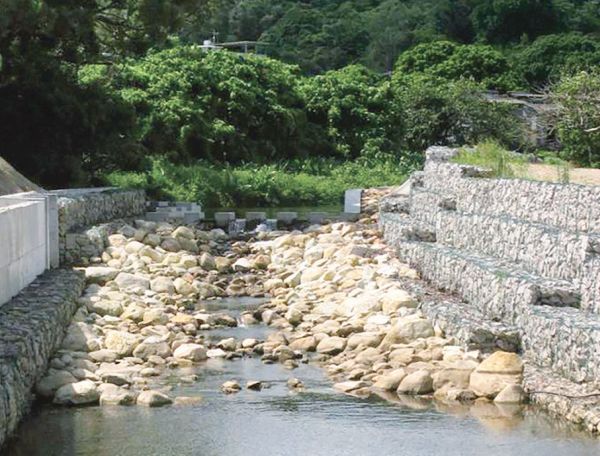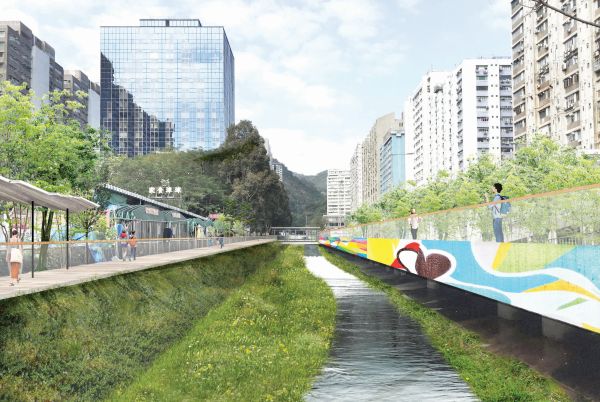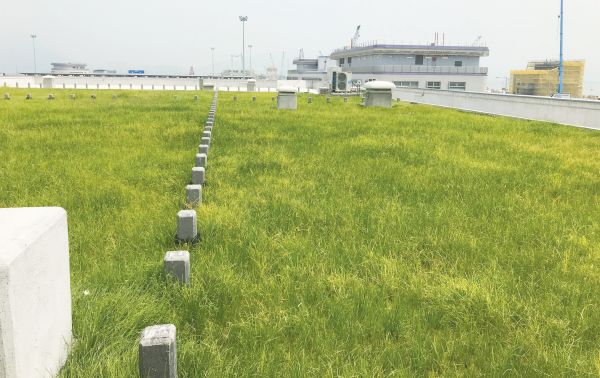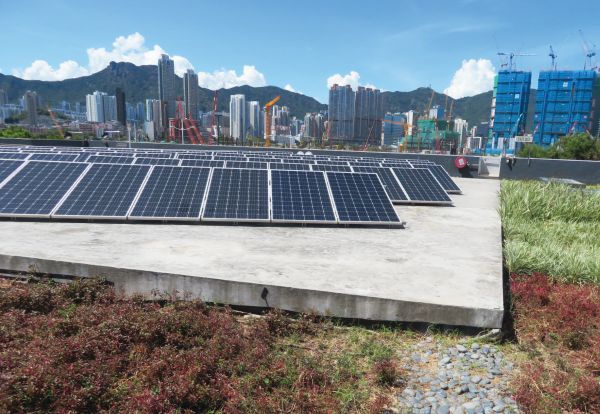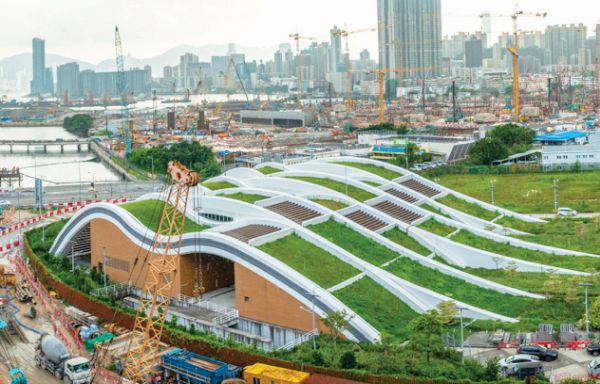Blue-Green Drainage Infrastructure
“Blue” refers to rivers and water bodies; “green” refers to landscape greening. Blue-Green Drainage Infrastructure is a modern stormwater management concept of making a city function like a sponge which can not only allow absorption, storage and purification of rainwater during rainy days, but also release the temporarily stored rainwater for utilisation as needed before discharging the excess rainwater into the sea. Embracing the concept of Blue-Green Drainage Infrastructure, the DSD strives to revitalise water bodies while actively greening sewage treatment facilities. By incorporating green and eco-conservation elements into a number of projects, we hope to beautify river environment and preserve river ecosystems, so that the public can enjoy a quality living environment.
Building “Rivers in the City”
Serving beyond the sole purpose of flood prevention, rivers nowadays are also urban waterscapes teeming with life. Apart from beautifying the environment, rivers can promote ecological conservation and provide shared space for the community. In response to the 2019 Policy Address initiative to develop and take forward the concept of “Rivers in the City”, the DSD has been implementing river revitalisation projects and introducing, when planning new development areas, waterbody rejuvenation facilities such as artificial flood attenuation lakes and river parks, thereby providing the public with quality river facilities and enhancing the environmental and social values of rivers.
Achievements of River Improvement Works
Ho Chung River Improvement Works
The DSD completed the Ho Chung River Improvement Works in 2009, alleviating the flood risk of the region. During the works period, we introduced ecological conservation features such as holes in the river walls and fish ladders to enrich the aquatic and riparian environment and enhance fluvial ecology.
Ho Chung River
Upper Lam Tsuen River Improvement Works
Upon completion of the Upper Lam Tsuen River Improvement Works in 2012, the river habitat has been reconstructed and the water quality of the river improved. Results of the project are very encouraging, with the numbers of bird, fish and dragonfly species restored to pre-project levels, and Hong Kong Warty Newt, a rare species occurring in Lam Tsuen River, is now more abundant than before.
Upper Lam Tsuen River
Kai Tak River Improvement Works
After the completion of the Kai Tak River Improvement Works in 2018, Kai Tak River can now withstand rainstorms of a 200-year return period, effectively alleviating flood risks to Choi Hung Road and its surrounding areas. By incorporating greening, landscaping and ecological elements into the project, we turned the 1.1-kilometre section of the nullah into the first urban green river corridor. Awash with flourishing greenery, the revitalised Kai Tak River has attracted many different species of birds and fish seeking a resting place. We have also set up a trail along Kai Tak River in Wong Tai Sin so that the public can learn more about the history, overview of improvement works and natural ecology of the river while enjoying the fruits of the greening and revitalisation works.
Kai Tak River
We are pressing on with the Tsui Ping River revitalisation works. Please refer to Chapter 4 - Core Responsibilities for details.
Plans to Revitalise Potential Nullahs and Rivers
The DSD has formulated the revitalisation schemes for Tai Wai Nullah (from Heung Fan Liu to Man Lai Court), Fo Tan Nullah (from Kwai Tei New Village to Hong Kong Sports Institute) and Jordan Valley Nullah (from Shum Wan Shan Pumping Station to Jordan Valley Swimming Pool), aiming to optimise the use of river spaces and demonstrate the multifunctionality of waterbodies as well as maintaining the drainage capabilities of the nullahs.
The revitalisation schemes for Tai Wai Nullah and Fo Tan Nullah aim to enhance the ecological value of the drainage channels, green the environment, promote a water-friendly culture, improve the community environment, and provide dry weather flow interceptors that can help improve water quality. To review the feasibility of the schemes, the DSD commenced investigation studies for the revitalisation schemes for Tai Wai Nullah and Fo Tan Nullah in April 2020.
Photomontage of Fo Tan Nullah
Photomontage of Tai Wai Nullah
The DSD is implementing landscaping works to part of the downstream area of Jordan Valley Nullah, above which a viewing platform is proposed to be built so as to furnish a leisure space. Moreover, we proposed providing pools and fish ladders in the upstream area to create ecological habitats for enhancement of the area's ecological value. The works commenced in March 2020, with completion targeted for 2022.
Photomontage of Jordan Valley Nullah
During the Hong Kong 2020 International Urban Forestry Conference, the first-ever organised by the Development Bureau, the DSD arranged for overseas experts to make a field trip to learn about Hong Kong's work on realising the concept of “Rivers in the City”. The DSD's landscape architect shared with them the background, challenges and river revitalisation concept of the Kai Tak River Improvement Works, as well as the green building features adopted at Kowloon City No. 1 Sewage Pumping Station (SPS).
The DSD's landscape architect shared with overseas experts the project of Kai Tak River Improvement Works
Integrating Facilities into the Environment and Community
When upgrading sewage treatment facilities, the DSD not only takes into account the development needs of the community, but also attaches great importance to the way in which facilities are connected with the environment and the community nearby. Apart from infusing green elements into sewage treatment facilities, we proactively adopt community inclusive designs to turn the drainage facilities into spaces that can be shared with the general public, thus improving public acceptance of the drainage facilities.
Roof Greening
Roof greening can reduce building energy consumption, beautify building appearance and improve biodiversity of the surrounding environment. Prior to construction of green roofs, we hired qualified professionals to make detailed assessment so as to ensure the structural safety of selected sites. During the year, the DSD carried out roof greening works at six of its facilities listed below:
Mui Wo Sewage Treatment Works
Lok Wo Sha Sewage Pumping Station No.2
Hong Kong-Zhuhai-Macao Bridge Sewage Pumping Station
To Kwa Wan Road Sewage Pumping Station
Kai Tak River Desilting Compound No.1
Kai Tak River Desilting Compound No.2
Community Inclusive Designs
The DSD actively transforms its drainage facilities into community facilities to provide citizens with communal space for rest and leisure, thereby imbuing the facilities with additional social meaning that goes beyond their intended use. We have incorporated various community inclusive design elements into the improvement works of Shek Wu Hui STW and Kwun Tong SPS.
Shek Wu Hui STW will be upgraded to Shek Wu Hui Effluent Polishing Plant. After completion of the project, parts of the facility will provide the public with communal spaces such as a bird-watching area, a riverside promenade and an ecological garden, allowing them to enjoy the natural scenery at River Sutlej and River Indus.
Photomontage of Shek Wu Hui Effluent Polishing Plant
The DSD is carrying out facility upgrade works at Kwun Tong SPS on the waterfront to transform the 11,000-square-metre roof of the SPS into a landscaped deck for recreational purposes. We will entrust an NGO with the task of conducting public engagement workshops to consult the community on the children's playground on the deck
Photomontage of landscaped deck of Kwun Tong Sewage Pumping Station





